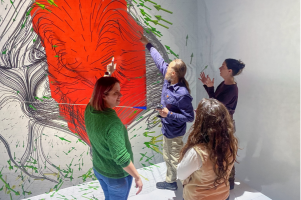Immersive X3D Data Visualization aids Virginia Tech cancer researchers quest for better brain tumor treatment
Primary tabs
Submitted by anita.havele on Mon, 2024-02-19 07:52

Immersive 3D visualization helps researchers with richer knowledge of fluid in tumors and could lead to advancements in understanding how glioblastoma tumors spread.

The Fralin Biomedical Research Institute at VTC study of interstitial fluid flow is the movement of fluid through the spaces between cells and blood vessels in the human body – in search of better ways to treat the deadly brain cancer glioblastoma multiforme.They create tissue-engineered models of the tumor microenvironment and use data to create two-dimensional representations of tumors. A richer knowledge of fluid in tumors could lead to advancements in understanding how glioblastoma tumors spread and how fluid flow may affect the delivery of cancer drugs to them.
Immersive 3D visualiztion can quickly help a researcher or designer debug a system or recognize an error in an equation, and it overcomes barriers in language and vocabulary, because everyone is seeing the same thing in front of them.
Standing inside a room-sized cube in the Visionarium, a red blob representing a tumor floated before and around them, wrapped in gray tubes portraying fluid flowing through the cancer. A richer knowledge of fluid in tumors could lead to advancements in understanding how glioblastoma tumors spread and how fluid flow may affect the delivery of cancer drugs to them.
The Munson team’s December visit to the Visionarium is just the beginning of the relationship. Lab members can also learn to use the development software and create their own visualizations. They were already buzzing with possibilities. Read More
Press Release:
No
Release Date:
Sat, 2024-02-10



